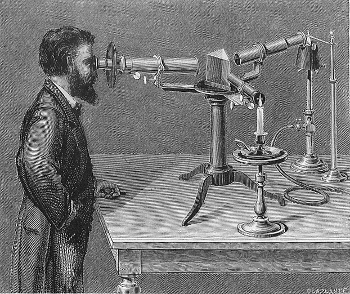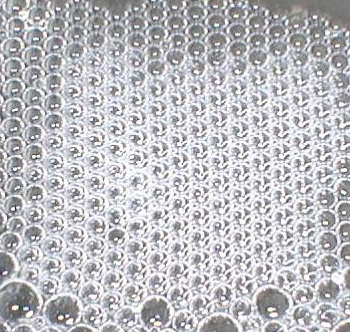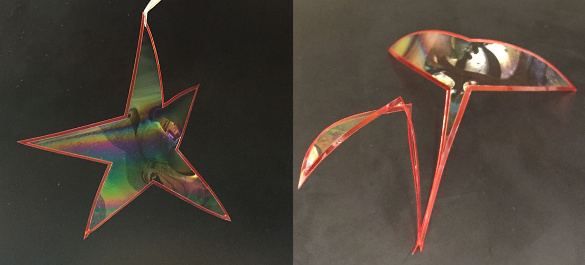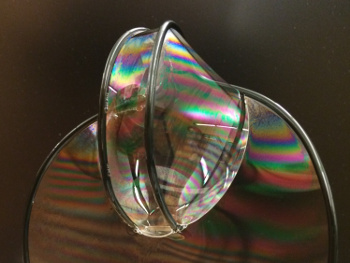Kirchhoff–Plateau Problem
June 15, 2017
A few
scientists have had the honor of having a
physical law named after them. Quite a few examples come to mind. In
physics, we have
Newton's law of universal gravitation,
Planck's law,
Coulomb's law,
Lenz's law,
Snell's law, and
Hooke's law. In
chemistry, we have
Avogadro's law,
Raoult's law, and
Boyle's law.
Electrical engineers have
Ohm's law, while
materials scientists have
Vegard's law and
Fick's law of diffusion.
Wikipedia lists many
physical laws named after people.
It's a rare honor to have a single law named after you, but
German physicist,
Gustav Kirchhoff (1824-1887) has
five eponymous laws.
• Kirchhoff's circuit laws - This law, beloved by electrical engineers, states that the algebraic sum of electrical currents at a node is zero. It's essentially a conservation law.
• Kirchhoff's law of thermal radiation - If a body is emitting and absorbing thermal radiation in thermodynamic equilibrium, its emissivity is equal to its absorptivity. One aspect of this law is that it's not possible to thermally radiate more energy than a black body at equilibrium.
• Kirchhoff equations of fluid dynamics - These equations describe how a rigid body will move in an ideal fluid.
• Kirchhoff's three laws of spectroscopy - These laws, subsequently explained by quantum mechanics, concern the emission and absorption spectra of gases.
• Kirchhoff's law of thermochemistry - This law relates the change in the enthalpy of a chemical reaction with temperature (dΔH/dT) to the difference in heat capacity between the products and reactants (ΔCp); that is, dΔH/dT = ΔCp.

An experimental physicist in his natural abode, the laboratory.
Here, Kirchhoff is using a spectrometer of his own design.
(An illustration from the History of Physics by Poul la Cour and Jacob Appel, 1896, via Wikimedia Commons.)
Kirchhoff, who in 1857, about the same time that many principles of
electromagnetism were being discovered, found that a
signal in an ideal
conductor travels at the
speed of light. It was Kirchhoff who coined the term "black body" in 1862, but it was as a student in 1845 that he discovered his circuit laws, a topic that became his
doctoral dissertation.
At the
University of Heidelberg (Heidelberg, Germany), he collaborated on spectroscopy with
Robert Bunsen,
inventor of the eponymous
Bunsen burner, jointly discovering
cesium and
rubidium in 1861. There's a
Bunsen–Kirchhoff Award for spectroscopy that's awarded by the
German Working Group for Applied Spectroscopy.
Soap bubbles are an inexpensive way to entertain
children, but they became useful in physics in the late 1940s. At that time,
Nobel laureate,
William Lawrence Bragg, and
John Nye of the
Cavendish Laboratory of
Cambridge University produced arrays of floating soap bubbles to
simulate atoms in
crystals.[1] They produced these
bubble rafts using a
solution of
glycerine (162
mL),
oleic acid (15.2 mL in 50 mL of water), and 73 mL of a 10% solution of
triethanolamine in water, the mixture
diluted to attain a desired
viscosity. From such a solution they created rafts of 100,000 or more
sub-millimeter bubbles, and they used this simulation to investigate such things as
grain boundaries and
dislocations.[1]

The beginning of good bubble raft.
Production of uniform soap bubbles is relatively easy using the mechatronics available today, but Bragg, and Nye devised an elegant way to form their bubble rafts in the 1940s.[1]
(Portion of a Wikimedia Commons image by Timothy Pilgrim.)
Soap bubble are
spherical for the reason that the
surface tension is minimized at each point. Likewise,
soap films, such as those attached to the loop used to make bubbles, are
minimal surfaces in which surface tension causes the films to minimize their surface area and
energy. A soap film on a loop is flat, but a soap film on a contorted loop of
wire will have a contorted shape that's a minimal surface for that shape.
Since the soap film is attached to the wire frame that holds it, a
mathematical model should include properties of the wire frame, which may be
flexible and
deformable by the surface tension of the soap film. In 1859, Kirchhoff found that the same equations that govern the motion of a heavy
top also describe a thin
elastic rod in
equilibrium. Since
Belgian physicist,
Joseph Plateau, was the first to
conjecture that the soap film formed on the wire frame spans a minimum area, independent of the shape of the frame, the extended problem of the film surface for a flexible frame is called the Kirchhoff–Plateau problem.
A team of
mathematicians from the
Okinawa Institute of Science and Technology Graduate University (Onna, Japan) and the
Università Cattolica del Sacro Cuore (Brescia,Italy) have looked more closely at the Kirchhoff–Plateau problem of the equilibrium shapes formed when a closed, flexible filament is spanned by a soap film. The filament was
modeled as a Kirchhoff rod, and the soap film was modeled by its surface tension.[2-3]
This interesting problem has had a long history, with the first satisfactory solution for the rigid filament Plateau problem discovered by
American mathematician
Jesse Douglas (1897-1965), winner of the 1936
Fields Medal.[3] In 2015,
Jenny Harrison of the
University of California, Berkeley, and
Harrison Pugh of the
State University of New York at Stony Brook (Stony Brook, New York) provided a proof for the complicated case in which multiple soap films meet each other in a junction.[3]
Since the filament holding the soap film in the Kirchhoff-Plateau problem is flexible, the surface tension of the soap film can change its shape, sometimes substantially. For example, as shown in the figure, the same loop can form a
swan- or
star-shape depending on the film's surface tension.[3] While the filament in the Plateau problem is
one-dimensional, the Kirchhoff-Plateau filament is actually a rod. While these filament rods are thin, they are still much thicker than the soap film, and the soap film can contact the rod at different points.[3]

Star, or swan? The same flexible filament can produce a different shape of the soap film for different surface tensions. (Okinawa Institute of Science and Technology Graduate University image.)
The Okinawa Institute mathematicians were able to capture all such
physical effects in their mathematical model. The system adjusted to a least energy configuration, independently of the
ratio of the competing forces between the surface tension of the soap film and the elastic response of the loop.[2-3] Says
Giulio Giusteri,
coauthor of the
paper that describes these results in the
Journal of Nonlinear Science, "Our solution of the Kirchhoff–Plateau problem brings beautiful mathematical results close to what happens in the physical world."[3]
Applications of this model might include new insights into how the shape of a
protein determines its interaction with
binding surface sites.[3] The Okinawa Institute team is now examining, via
computer simulations, how their model can predict the behavior of physical systems.[3]

This soap film is an example of multiple film surfaces joining together, a condition first investigated by Harrison and Pugh (see above).
(Okinawa Institute of Science and Technology Graduate University image.)
References:
- Lawrence Bragg and J.F. Nye, "A Dynamical Model of a Crystal Structure," Proc. R. Soc. Lond. A., vol. 190, no. 1023 (September 9, 1947), pp. 474-481, doi:10.1098/rspa.1947.0089. See also the PDF file at MIT.
- Giulio G. Giusteri, Luca Lussardi, and Eliot Fried, "Solution of the Kirchhoff-Plateau Problem," Journal of Nonlinear Science, , vol. 27, no. 3 (June 2017), pp. 1-21, DOI: 10.1007/s00332-017-9359-4. This is an open access article with a PDF file available here.
- Greta Keenan, "Bursting the Bubble: Solution to the Kirchhoff-Plateau Problem," Okinawa Institute of Science and Technology Graduate University Press Release, March 31, 2017.
Permanent Link to this article
Linked Keywords: Scientist; physical law; physics; Newton's law of universal gravitation; Planck's law; Coulomb's law; Lenz's law; Snell's law; Hooke's law; chemistry; Avogadro's law; Raoult's law; Boyle's law; electrical engineers; Ohm's law; materials science; materials scientist; Vegard's law; Fick's law of diffusion; Wikipedia; list of scientific laws named after people; German; physicist; Gustav Kirchhoff (1824-1887); eponymous; Kirchhoff's circuit laws; algebraic sum; electrical current; node; conservation law; Kirchhoff's law of thermal radiation; emission spectrum; emitting; absorption (electromagnetic radiation); absorbing; thermal radiation; thermodynamic equilibrium; black body; Kirchhoff equations of fluid dynamics; equation; rigid body; rigid body dynamics; perfect fluid; ideal fluid; Kirchhoff's three laws of spectroscopy; quantum mechanics; spectral line; spectra; gas; Kirchhoff's law of thermochemistry; enthalpy; chemical reaction; temperature; heat capacity; product; reagent; reactant; experimental physics; experimental physicist; laboratory; spectrometer; Wikimedia Commons; electromagnetism; signal; electrical conductor; speed of light; thesis; doctoral dissertation; University of Heidelberg (Heidelberg, Germany); Robert Bunsen; invention; inventor; Bunsen burner; cesium; rubidium; Bunsen–Kirchhoff Award; German Working Group for Applied Spectroscopy; soap bubble; child; children; Nobel laureate; William Lawrence Bragg; John Nye; Cavendish Laboratory; University of Cambridge; Cambridge University; simulation; simulate; atom; crystal; bubble raft; aqueous solution; glycerol; glycerine; milliliter; mL; oleic acid; triethanolamine; concentration; dilute; viscosity; millimeter; grain boundary; dislocation; bubble raft; mechatronics; sphere; spherical; surface tension; minimal surface; energy; wire; mathematical model; deflection; flexible; deformation; deformable; top; elasticity; elastic; rod; mechanical equilibrium; Belgian; Joseph Plateau; conjecture; mathematician; Okinawa Institute of Science and Technology Graduate University (Onna, Japan); Università Cattolica del Sacro Cuore (Brescia,Italy); American; Jesse Douglas (1897-1965); Fields Medal; Jenny Harrison; University of California, Berkeley; Harrison Pugh; State University of New York at Stony Brook (Stony Brook, New York); swan; star; one-dimensional; ratio; Giulio Giusteri; coauthor; scientific literature; paper; Journal of Nonlinear Science; protein; binding surface site; computer simulation.